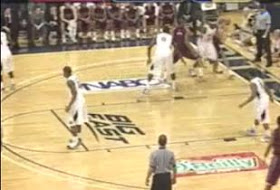In this play in OT against Creighton, the Wolverines execute the backdoor lob to perfection. Setup is high-post open motion. 4 players on the perimeter, forward at the high post. The forward pops outs to receive a pass for what would normally be a ball reversal to the side of the floor. This is the most crucial part for any motion offense. Players must setup their cuts. If the forward simply cuts backdoor here, it won't work because the defender starts in position to guard against it. The forward must really plant his top foot and use his hands to indicate he is ready to receive the pass up top,

The defender bites and overplays the ball reversal pass. This is where eye contact and communication between ball-handler and player are crucial. Both players realize the overplay right away, the forward plants hard of the top foot and uses his lateral quickness to go backdoor,

The ball-handler sees it and looks to lob the ball to the forward guiding him to the rim,

What seems like a simple play, actually takes many many reps and whole-part-whole progressions to teach. It's important to remember that motion offense takes time and you must be patient to teach it. You can't expect to put it in late November and expect your players to win the season opening tournament. It literally takes hundreds of reps in multiple situations before players get used to how and when to do what, and to get used to their teammates. But once they get it, motion offense is the most beautiful thing to watch, it's basketball offense at its purest.
Coach Beilein doesn't have any DVDs produced but if you're a fan of motion offense like me, then check out Bobby Knight's new DVD on motion offense. The DVD includes 2 hours worth of motion wisdom from the legendary college coach.














